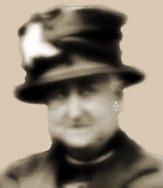Lady Bracknell ponders on the peculiarities of maquillage
During Lady Bracknell's youth, elderly ladies who had drawn eyebrows on their forehead with a pencil were often to be encountered. There was a theory, popular at the time, that excessive plucking of the eyebrows over a long period of time could lead to the refusal of this important facial feature ever to grow back. (Lady Bracknell is unsure of the validity of this theory as, in her own limited experience of depilation from less immediately obvious parts of the body, trying to persuade hair not to grow back is an exercise somewhat akin in futility to King Canute's attempts to convince the incoming waves that they would really much rather not dampen the hem of his royal robes.)
Be that as it may, what always struck her ladyship about such women was their marked inability to remember the proper situation of their long-lost eyebrows, and their consequent permanent expressions of surprise. (Not to mention the fact that an eyebrow drawn in crayon by a hand palsied with age bears so little resemblance to the genuine article as to render the entire exercise completely pointless.) She has been known to muse upon the question of whether this misplacing of the eyebrow was a deliberate - if wholly deluded - attempt to present a more youthful appearance. Although she has never understood in what way surprise might be assumed to correlate with youth.
It being the biological purpose of the eyebrow to protect the eye, given the propensity for excessive cranial perspiration that she has inherited from her esteemed father, Lady Bracknell would very much miss her own eyebrows were they suddenly to disappear and has, in fact, been known to wish for a fuller set than she actually possesses.
Lady Bracknell, if she had considered the matter at all, would have assumed that the practice of replacing the eyebrow with a facsimile in crayon had died out some years ago. Imagine, then, her surprise on seeing the very same phenomenon sported by a young woman on the omnibus yesterday morning. This young woman appeared to be in possession of her own hair, and clearly took some pains over her appearance generally. (As an aside, Lady Bracknell was rather concerned for the continuing integrity of the young woman's right earlobe, given the fact that the cord of her personal music device was very much entangled with one of her elaborate earrings.)
Assuming, then, that the crayoned replacements for eyebrows were a deliberate ploy, only one question remains:
Why?
Lady Bracknell is hopeful that her younger readers will be able to provide a satisfactory explanation. Although, as they are young ladies of more than average good sense, she suspects that they may have little interest in modish trends in powder and paint. Nevertheless, she awaits their comments with interest.
Be that as it may, what always struck her ladyship about such women was their marked inability to remember the proper situation of their long-lost eyebrows, and their consequent permanent expressions of surprise. (Not to mention the fact that an eyebrow drawn in crayon by a hand palsied with age bears so little resemblance to the genuine article as to render the entire exercise completely pointless.) She has been known to muse upon the question of whether this misplacing of the eyebrow was a deliberate - if wholly deluded - attempt to present a more youthful appearance. Although she has never understood in what way surprise might be assumed to correlate with youth.
It being the biological purpose of the eyebrow to protect the eye, given the propensity for excessive cranial perspiration that she has inherited from her esteemed father, Lady Bracknell would very much miss her own eyebrows were they suddenly to disappear and has, in fact, been known to wish for a fuller set than she actually possesses.
Lady Bracknell, if she had considered the matter at all, would have assumed that the practice of replacing the eyebrow with a facsimile in crayon had died out some years ago. Imagine, then, her surprise on seeing the very same phenomenon sported by a young woman on the omnibus yesterday morning. This young woman appeared to be in possession of her own hair, and clearly took some pains over her appearance generally. (As an aside, Lady Bracknell was rather concerned for the continuing integrity of the young woman's right earlobe, given the fact that the cord of her personal music device was very much entangled with one of her elaborate earrings.)
Assuming, then, that the crayoned replacements for eyebrows were a deliberate ploy, only one question remains:
Why?
Lady Bracknell is hopeful that her younger readers will be able to provide a satisfactory explanation. Although, as they are young ladies of more than average good sense, she suspects that they may have little interest in modish trends in powder and paint. Nevertheless, she awaits their comments with interest.











7 Comments:
It all started with Elizabeth I apparently. Actually, it was earlier than that. My sister has done this sort of thing and I really don't understand it. Then again I don't understand the trichophobia evident in women's disgust at the idea of having hairy armpits - a sexual stimulus - and all the other weird and often unpleasant things they do to themselves in the name of beautification. For example, what are those things which look like speculums and are applied to the eyelashes? What is that about? I have many such unanswered questions.
Here is a brief history of hair removal which suggests that the removal of eyebrows is a fashion which has come and gone throughout the history of civilisation.
Lady Bracknell is, as ever, in awe of the Goldfish's erudition, and thanks her for the link. She does, however, now feel slightly ill. The mere prospect of using sandpaper to depilate her legs and armpits is enough to bring on a bout of her ladyship's troublesome eczema.
Lady Bracknell recalls that she read a book about body decoration many years ago, in which it was explained that the British habit of removing a lady's lower ribs surgically to enable her to obtain the then-popular tiny waist was far more injurious to health than habits such as foot-binding which were, of course, considered by the British to be utterly barbaric.
The subject matter is fascinating,but Lady Bracknell has never understood why ladies (or, in some cases, gentlemen) voluntarily submit to procedures which are, at best, time-consuming and, at worst, dangerous, merely to conform with some accepted physical norm. She has also never seen the point of wearing shoes which are elegant but uncomfortable. Her ladyship experiences an excellent sufficiency of pain already without adding to it by having her toes pinched and the skin on her ankles removed.
Actually, the Goldfish does confess that her preferred method of hair removal when she has to expose her legs in public is a sort of (very fine) sand-paper arrangement. It feels like rubbing one's legs with a dry flannel, that's all.
I find this preferrable to shaving, which tends to cause a rash or waxing which resulted in my legs colouring to various shades of red, purple, green and black over the following days. By the time the bruising had quite disappeared, the hair was back.
However, like her Ladyship, the Goldfish's ultimate preferrance is to dress in modest, comfortable yet elegant and flattering garments which take a matter of moments to put on rather than to sacrifice her precious time, energy, money and comfort in the pursuit of bodily baldness or any other aesthetic ideal.
Oooooooouch!
I must say I'm a little surprised at the derth of young gentlewoman without eyebrows on Lady Bracknell's estate and it's surrounding environs.
In my home town it is rare to find a young woman WITH eyebrows. Especially amongst the lower classes/
Here are the instructions from The New Home Encyclopaedia (published 1932, and a snip at eleven and five) on "How to Make-up the Eyebrows".
"It must be left to a woman's common sense to decide whether to be content with what Nature has given her in the shape of eyebrows, or make an attempt to alter them. The eyebrow in its natural state is a characteristic feature of the face.
"When hairs meet in the centre of the nose, any woman can be excused for having them removed, to make her eyebrows more natural and becoming; if the hairs have grown irregularly or one eyebrow is longer or broader than the other, it is a simple matter to remedy the defect with the aid of a pair of small tweezers, and a little fortitude.
"First wet the eyebrow with soap and water to soften the skin and the hairs, then stand in a good light before a looking-glass and take hold of each hair firmly with the tweezers. Pull the hairs in the direction of the growth and they should come out easily, without breaking. If they break, attempt to remove the remainder of the hair, or leave it to grow again, then remove.
"Eyebrow pencils are obtainable in shades to match eyelash cosmetics. They may be used to darken the hairs, but care must be taken to see that both eyebrows match, not only in width, but in length. It is really the work of an expert to imitate an eyebrow with a pencil, a task too difficult to be attempted by any amateur without special tuition."
Lady Bracknell feels that her readers could be forgiven at this point for wondering just what degree of expertise might be required to make a pencil stuck to a woman's forehead resemble an eyebrow, but it may be that she is over-critical of the author's syntax.
Fond though she is of her Encyclopaedia, she is not sure that the advice it contains should always be followed to the letter. Particularly given that it recommends that hair should be washed a maximum of once a fortnight. A recommendation which may go a long way towards explaining the popularity of hats in the early thirties...
I will venture to say, ma'am, that it's possible to actually shampoo one's hair much less than most personages in America do. (I cannot speak to the habits of the English). As shampoo removes the hair oils, those of us with naturally dry hair can either shampoo less often or use a vast and expensive amount of various "products" on the hair. The cost grows exponentially if one follows the oldfashioned custom of not cutting the hair short at maturity, but putting it up instead. I myself have found that a nice rinse with water almost too hot to be borne followed by a nice cool rinse does wonders to refresh my hair between shampoos.
I would further like to commend your ladyship on her decision to share her observations on life with the rest of the world, as I for one find them thought-provoking and gently amusing, and would, if she ever went to England, definitely attempt to meet Her Ladyship and her editor face to face. --Alexandra Lynch
Post a Comment
<< Home